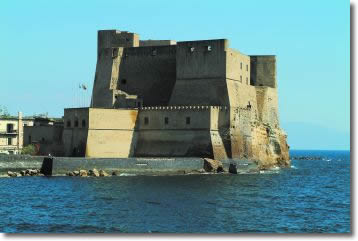
The first settlements were made in the ninth century BC, nearly 3000 years ago, when "Anatolian and Achaean merchants and travellers arrived in the gulf on their way to the mineral lands of the high Tyrrhene" and founded Parthenope in the area which includes the isale of Megaride (the present-day Castel dell'Ovo) and the Promontory of Monte Echia (the present-day Monte di Dio and Pizzofalcone).
The first inhabited nucleus was a small commercial harbour which, thanks to the continuing trade traffic, expanded and became a town in its own right. At that time, however, the coastline was subject to continual violent clashes in the struggle for trade dominance, in particular between the Greeks and the Etruscans. The supremacy gained by the Etruscans led to the inevitable decline of Parthenope, which was repopulated and rebuilt under the name of Palepolis round about 474 when the Greek settlers managed to establish their supremacy.
This created a situation of greater freedom to settle on the coasts of Campania and found new settlements. Further south, a new and larger economic and commercial centre was built, protected by a system of towers and alterations. The new city was named Neapolis in Greek, this means "new city"), while the eastern part, including Palepolis, became a periphery far from the hubbub of the city, a place where one could stay in peace and quiet and, from the time of the Roman Empire, towards the end of the 1st century BC, the sumptuous patrician villas were built.
In the area of Pizzofalcone, more precisely at Via Nicotera no.10, there is a necropolis which goes back to Parthenope founded by the people of Cumae, and a few other archeological remains such as the villa belonging to a later period built in the late Republican era by the Roman nobleman Lucullo.
There are few remains of this legendary villa because of the later and repeated building that has gone on over it. After the death of Lucullo, the villa became part of the imperial demesne and was used as a prison for certain members of the imperial families during the numerous conspiracies and battles for succession to the throne of Rome.
Today, the area that at one time was part of the old city (Palepolis) is partly occupied by Castel dell'Ovo on the isle of Megaride, and by luxury housing, hotels and shops. At the end of this initial itinerary, we can take a rest in Piazza Trieste e Trento and have a coffee before going on to Corso Umberto along Via\San Carlo, Via Medina and Via San Felice.